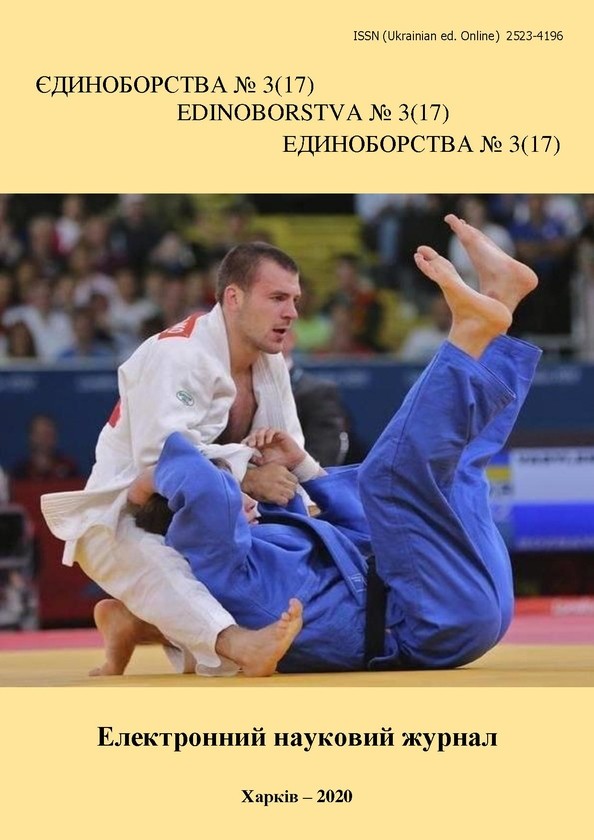Analysis of a questionnaire survey of women of the DGUVD who are engaged in martial arts
DOI:
https://doi.org/10.15391/ed.2020-3.06Keywords:
questionnaire survey, martial arts, women, cadets, reasonsAbstract
Purpose: using a questionnaire to investigate the reasons that encourage women to engage in martial arts at the Dnipropetrovsk State University of Internal Affairs. Material and methods. The study involved women aged 18 to 43 years old from the constant and variable composition of the Dnipropetrovsk State University of Internal Affairs (hereinafter referred to as the DGUVD). A survey was conducted of all university women who expressed a desire to participate in the study. During the study, the following methods were used: questionnaire survey, systematization and generalization of theoretical and practical experience of specialists in the field of martial arts, methods of mathematical statistics. Results: analysis of a survey of women (428 people) on the staff of the Department of Internal Affairs, who expressed a desire to participate, reflects the following results: minimal activity is present in 11 people (3 %), normal physical activity - 78 people (18 %), physical activity 3 times in Sunday - 199 people (46 %), physical activity 5 times on Sunday - 81 people (18 %), physical activity every day - 33 people (7,7 %) and physical activity twice a day - 10 people (2,3 % ) Also, 16 people (3,7 %) chose their answer, among which women most often noted that the level of physical activity depends on their mood. According to the results of a survey of women in the staff of the Leningrad State Internal Affairs Directorate, there was a definition of the circle of women who are engaged or were engaged in martial arts. So out of 428 women surveyed, 185 (43 %) had never before practiced martial arts and did not want to; 192 (45 %) women are currently engaged in martial arts; 51 (12 %) women who used to be in martial arts, but are not currently engaged. Conclusions. A questionnaire survey made it possible to investigate the reasons that prompt women to engage in martial arts in the Department of Internal Affairs: the specifics of working in the police force are 53 women (22 %); to ensure physical health - 31 women (13 %); for self-defense - 24 women (10 %); for body correction - 27 women (12 %); to increase the level of physical fitness - 24 women (10 %); with the goal of self-realization in sports - 24 women (10 %); in connection with heredity - 15 women (6 %); to ensure gender equality - 10 women (4 %), 10 women (4 %); 7 women (3 %) follow fashion trends and to splash out negative emotions and aggression. In addition, 18 women (7 %) noted their answer option, among which they indicated that they practiced martial arts «out of boredom» and «because there is an opportunity to attend free sections at the university».
References
Бішон, М. (1999). Окінавське карате: вчителя, стилі, таємні традиції і секретна техніка шкіл військового мистецтва. Фаир-прес, Москва.
Джонс, Д. (2003). Традиційні бойові мистецтва Японії. Фаир-прес, Москва.
Жунева, К. В. (2017). Особливості підготовки спортсменок, які займаються боксом. Пермський державний гуманітарно-педагогічний університет. Кафедра теорії та методики фізичної культури.
Іванов-Катанский, С. А. (2000). Базова техніка карате. Фаир-прес, Москва.
Лісіцин, В. О. (2013a). «Школа боксу» як основа техніко-тактичної підготовки жінок-боксерів. Вчені записки університету ім. П.Ф. Лесгафта, (9 (103)), 63-67.
Лісіцин, В. О. (2013b). Жіночий бокс: історія і сучасність. Вчені записки університету ім. П.Ф. Лесгафта, (5 (99)), 54-58.
Махінько, М. П., Ставрінов, М. Р., Лукіна, О. В., & Кусовська, О. С. (2015). Історія розвитку олімпійських видів спортивних єдиноборств (боротьби греко-римської, вільної, дзюдо та тхеквондо). Методичні рекомендації для самостійної роботи здобувачів вищої освіти з дисципліни «ТМ боротьби», ТМС обраного виду спорту. Дніпро.
Митчик, О. П. (2009). Особливості мотивації до зайняти фізичними вправами у жінок, які тренуються в оздоровчих клубах. Фізичне виховання, спорт і культура здоров'я у сучасному суспільстві, (1), 55-58.
Передельский, А. А., & Султанова, Р. А. (2012). Гендерна проблема жіночого боксу. Вісник спортивної науки, (3), 87-92
Раєвський, Д. А., Домащенко, В. С., & Харатов, В. С. (2013). Диференціювання засобів навчально-тренувального процесу в жіночому боксі. Вчені записки університету ім. П.Ф. Лесгафта, (7 (101)), 76-81.
Саєнко, В. Р. (2010). Система кіокушинкай карате: основи наукового пізнання спортивної майстерності, військового ремесла, військового мистецтва: Монографія. Українська асоціація кіокушинкай карате. СПД Рєзніков ВС, Луганськ.
Саєнко, Ст., & Іванчикова, С. М. (2010). Формування навичок самооборони у жінок за допомогою базових приймів техніки різних видів східних єдиноборств. Інноваційні технології в галузі фізичного виховання, спорту, рекреації та валеології. Вип. 4, 196.













